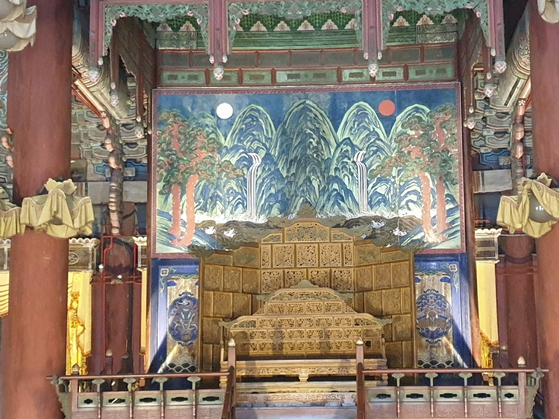Our Treasure Ilwolobongdo [Photo Essay Contest]

The Korea JoongAng Daily hosted its first photo essay contest for elementary, middle and high school students on the theme: “Promote the beauty of Korea to foreign countries." The contest ran from October to November. Photos containing scenes of traditional culture, family love, places to see and tasty treats in Korea were submitted for the contest.
For people who participated but didn't win a prize:
Yoong Kim from Seoul Do-Sung Elementary School submitted the following photo essay as a elementary school-level entry.
Have you ever been to a Korean traditional palace? If you have, what did you see behind the throne of the king? You must have seen a painting called the “Ilwolobongdo,” one of the treasures of the Joseon dynasty. This year, I visited Changdeokgung palace where I met two Ukrainian students. I taught them about the history of the Ilwolobongdo painting, its significant features, and the beauty that it shows.
Firstly, I explained to the foreign students that the painting's origin is said to be from the Cheonbo, a book of Chinese poetry, which could explain its unique artistic elements. The Ilwolobongdo is a royal painting that is only allowed to be placed at the five main palaces across the Joseon dynasty, namely: Gyeongbokgung, Gyeonghuigung, Changgyeonggung, Changdeokgung, and Deoksugung. During the Joseon period, the culture was influenced by Confucianism, so theart was too. The kings needed to rule the country with pride. So, with the Ilwolobongdo strongly behind them, they led the people with honor. The painting was so important to the life of the king, that wherever the king went, the painting also went. For example, if the king died, the painting went inside the casket with his dead body.
Secondly, I told the students that the court paintings in the Joseon period, such as the Ilwolobongdo, were very different from the paintings of the normal people at that time. They differed in size, style, material, and content. In the Ilwolobongdo, there is a sun, a moon, a waterfall, some pine trees, and five huge mountains. Each of these represents important elements. The sun represents the king. The moon represents the queen. The waterfall represents the normal people of Joseon. The evergreen pine trees represent the loyal officials. The five mountains represent the territory of Joseon. Most importantly, the picture itself represents the power and dignity of the King.
Lastly, the Ukrainian students wanted to know why the Ilwolobongdo is so important. I said that I think the Ilwolobongdo contains our ancestor’s intelligence and courage. Also, I think the way the artists represented the whole of Joseon by drawing a picture of nature, shows how clever they were. I think the most beautiful part of Ilwolobongdo is that the painting is incomplete if the king is not on the throne. The king needs to sit on the throne, beneath the mountains, between the pine trees and the waterfalls, and next to the moon. It’s beautiful that there is a painting that includes a real person. I think each part of the painting shows the unity and harmony of the Korean peninsula. This means that all of Korea is precious and that we have strong leadership.This was the most important message to teach the foreign students.
In conclusion, in this essay, I talked about the history and the significant features of the painting. Additionally, I also explained the beauty and importance of this painting. When I met the Ukrainian students at Changdeokgung palace I thought that they should know more about Ilwolobongdo because it’s wonderful that painters from the Joseon dynasty cherished their culture, and how Korean people still cherish their culture today.I took a picture of a painting, but it's not just a pretty picture -it's a treasure, a Korean treasure.
By Yoong Kim, Seoul Do-Sung Elementary School










with the Korea JoongAng Daily
To write comments, please log in to one of the accounts.
Standards Board Policy (0/250자)